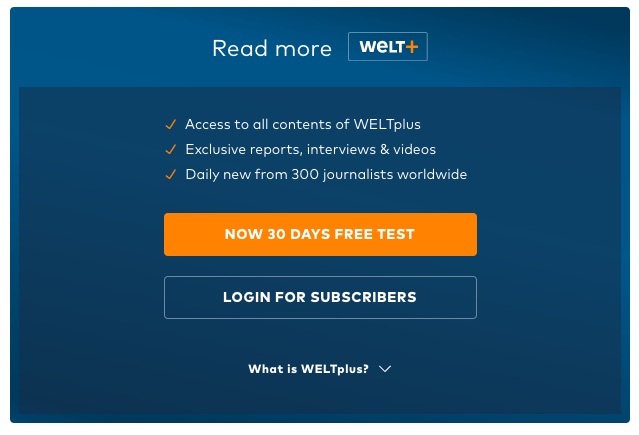Getting people to pay for content is tough, but Axel Springer news publication Die Welt has made progress by changing its pay model.
In September 2016, the German daily switched from a metered model, where users could access 20 free articles a month, to a freemium model, where about 15 percent of its content requires a digital subscription. WeltPlus, the subscription product, costs €19.99 ($23.40) a month and allows the publisher to showcase its most exclusive content. Die Welt has 78,000 digital subscribers. The publisher wouldn’t say how much that number has grown, but Dominik Stiefermann, vp of consumer business for Axel Springer subsidiary WeltN24, which operates Die Welt and TV broadcaster N24, said his personal goal is to get to 100,000 subscriptions in 2018.
“The most important thing is, we need to know the customer data and the website data, and we need the right people, those from e-commerce and analytics companies, to bring it together,” he said.
Die Welt uses many marketing channels to drive subscriptions, including social, display ads, email newsletters and article polls through polling company Opinary. So-called premium articles such as in-depth interviews with politicians, columnists, articles on house construction and investigative reporting convert the highest number of readers to subscribers. Editors decide which content is premium, using article scores from Die Welt’s analytics system that are based on the number of pageviews, time spent on the article page, video views, social shares, bounce rate and subscription conversion.
“We get good reach. We have lots of customers at the top; then we optimize the sales funnel with different offers and checkout payments using what we know from e-commerce,” said Stiefermann. “The best starting point is the premium articles.”
Die Welt has spent the last year testing several hundred versions of conversion messages on premium articles, experimenting with features such as layout, button size, a shorter funnel, more text and images and video before the paywall.

Die Welt also now urges users to register to get email newsletters and access to comment on articles.
To celebrate the freemium model’s first birthday in September, Die Welt opened the paywall for 24 hours to anyone willing to register. To get people to register, Die Welt also started sending an email this month from the editor-in-chief as another perk.
Retaining readers is more complicated than acquiring them, Stiefermann said. Die Welt has created six customer groups that it uses to figure out the best way to counteract signs that people are about to cancel their subscription. The groups are based on about 25 metrics, including how often people visit the site, how much time they spend on site, how many times they visit before subscribing and what types of articles they favor. Algorithms decide how they are contacted if they look like they will cancel their subscription. In some cases, this means picking up the phone to offer them a better price.
More in Media

Digiday’s comprehensive guide to what’s in and out for publishers in 2026
Adaptability stopped being a nice-to-have for publishers years ago; it became a survival skill. Here’s a look at Digiday’s guide to what’s in and out for 2026.

Here are the biggest moments in AI for publishers in 2025
Here are some of the moments that defined how publishers adapted to the AI era this year.

Digiday+ Research roundup: Gen Z news consumption and diversification in the DSP space were 2025’s top trends
As 2025 winds down, we rounded up the biggest trends of the year, based on the data that resonated the most with Digiday’s readers.








